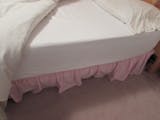
"Duvet covers are essential for protecting your comforter and adding a touch of style to your bedroom."
The Importance of Duvet Covers for Bedding
Duvet covers are essential for protecting your comforter and adding a touch of style to your bedroom. They come in various materials, patterns, and colors, making them a versatile alternative to traditional bedding.
Different Types of Duvet Covers

- Cotton Duvet Cover
- Flannel Duvet Cover
- Sateen Duvet Cover
- Silk Duvet Cover
- Linen Duvet Cover
Materials for Duvet Covers
- Cotton Duvet Covers: Cotton duvet covers are the most popular choice due to their soft and breathable nature. They come in various thread counts and are ideal for summer months.
- Silk Duvet Covers: Silk duvet covers are luxurious and hypoallergenic. They require careful washing and are perfect for adding a touch of elegance to your bedroom.
- Linen and Flannel Duvet Covers: Linen and flannel duvet covers are perfect for winter. Flannel is made from cotton and provides warmth, while linen has a textured look and feel.
Sizes and Measurements for Duvet Covers

- King Size Duvet Covers: Measure 108 x 96 inches, ideal for couples who need more space.
- Queen Size Duvet Covers: Measure 90 x 90 inches, suitable for couples who don't need as much space.
- Twin Size Duvet Covers: Measure 68 x 86 inches, perfect for single beds.
Closure Types of Duvet Covers

- Button Closure Duvet Covers: Have buttons sewn onto the opening at the foot of the cover, making it easy to change the bedding.
- Zipper Closure Duvet Covers: Feature a zipper that runs along the side of the cover, providing a secure fit.
- Tie Closure Duvet Covers: Have ties at each corner of the cover, which can be tied in loops around the duvet for a snug fit.
Design and Style of Duvet Covers
- Solid Color Duvet Covers: Come in a variety of colors, including neutral tones and bold hues, and are versatile and easy to match with any decor style.
- Printed Duvet Covers: Feature patterns, designs, or images printed onto the fabric, adding a pop of color and personality to a bedroom.
- Embroidered Duvet Covers: Have intricate designs or patterns sewn onto the fabric, adding texture and visual interest to a bedroom.
Thread Count of Duvet Covers

What is Thread Count?
Thread count refers to the number of threads woven into one square inch of fabric. A higher thread count generally indicates softer and more luxurious bedding.
Thread Count in Relation to Duvet Cover Quality
When it comes to duvet covers, a higher thread count can mean a softer and more comfortable sleeping experience. However, thread count is not the only indicator of quality, as the type of material and weave also play a role.
Care and Maintenance of Duvet Covers
To clean a duvet cover, follow the care instructions provided on the label. Typically, duvet covers can be machine washed on a gentle cycle with mild detergent. Some covers may also be tumble dried on low heat. Avoid using bleach or fabric softeners to extend the lifespan of the duvet cover.
The frequency of washing a duvet cover will depend on personal preference and usage. Generally, it is recommended to wash duvet covers once every two to four weeks.
Benefits of Duvet Covers

Protection for Your Comforter: One major benefit of using a duvet cover is that it provides protection for your comforter. A duvet cover can protect your comforter from spills, stains, and general wear and tear, extending its lifespan.
Easy to Change and Swap Out: Another benefit of using a duvet cover is that it is easy to change and swap out. With a duvet cover, you can easily change the look and feel of your bedding without having to replace your entire comforter.
In Conclusion
Duvet covers are available in various materials and styles, making them a versatile and stylish addition to your bedding. They not only protect your comforter but also allow for easy changes and swaps. Consider the type of material, thread count, and design when choosing the perfect duvet cover for your bedroom.



